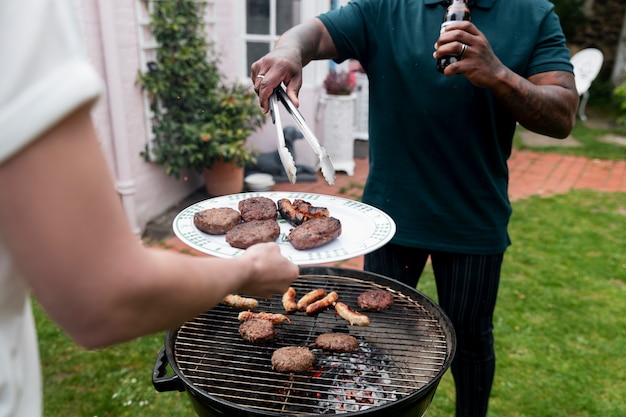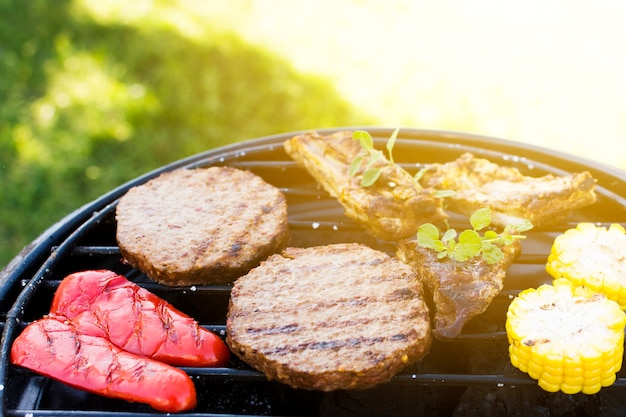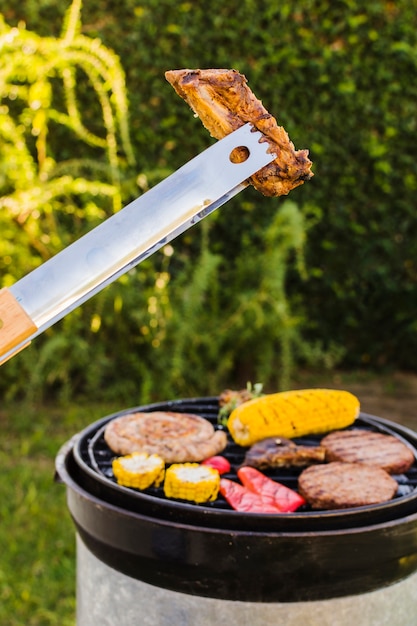Should you cut a burger in half?
When it comes to enjoying a delicious burger, the question of whether to cut it in half or not can spark a lively debate. Some argue that cutting a burger in half allows for easier handling and better portion control, while others believe that keeping it whole preserves the integrity of the burger and enhances the overall dining experience. So, should you cut a burger in half?
The case for cutting
One argument in favor of cutting a burger in half is the practicality it offers. By slicing it in two, you create a more manageable size, making it easier to handle and reducing the risk of toppings sliding off or the burger falling apart. This can be particularly beneficial for larger burgers with multiple patties, generous toppings, and a taller stature.
Additionally, cutting a burger in half can help with portion control. By visually dividing the burger into two halves, you may be more mindful of how much you’re consuming and potentially reduce overeating. This can be especially relevant if you’re watching your calorie intake or trying to maintain a balanced diet.
“Cutting a burger in half allows for easier handling and better portion control.”
The case against cutting
On the other hand, many burger enthusiasts argue that keeping the burger whole is essential for the overall experience. They believe that cutting the burger disrupts its structural integrity and can lead to a loss of juiciness and flavor. A burger is meant to be enjoyed as a cohesive unit, with each bite combining all the ingredients in perfect harmony.
Furthermore, leaving the burger intact allows you to fully appreciate its size and presentation. Burgers have become a work of art in themselves, with towering stacks of ingredients that make for stunning food photography and an Instagram-worthy dining experience. Cutting it in half might diminish this visual appeal.
“A burger is meant to be enjoyed as a cohesive unit, with each bite combining all the ingredients in perfect harmony.”
The verdict: It depends!
Ultimately, whether you should cut a burger in half or not depends on your personal preference and the specific circumstances. If you’re dealing with a particularly large or messy burger, cutting it in half may make it more manageable and less likely to fall apart. On the other hand, if you want to fully savor the burger and appreciate its aesthetic appeal, keeping it whole might be the way to go.
Remember, there’s no right or wrong answer when it comes to enjoying a burger. The most important thing is to relish every bite and find what works best for you.
“Ultimately, whether you should cut a burger in half or not depends on your personal preference and the specific circumstances.”
Is it bad if I undercook a burger just a little bit?
When it comes to cooking burgers, ensuring they are cooked to the right temperature is crucial for both taste and safety. Undercooking a burger, even just a little bit, can pose several risks.
Food Safety Concerns
Undercooking a burger can increase the risk of foodborne illnesses, such as salmonella or E. coli. These bacteria are typically found in raw or undercooked meat and can cause symptoms like diarrhea, vomiting, and abdominal cramps.
To prevent foodborne illnesses, it’s important to cook burgers thoroughly until they reach an internal temperature of 160°F (71°C). This ensures that any harmful bacteria present in the meat are killed, making the burger safe to consume.
Affect on Taste and Texture
In addition to safety concerns, undercooked burgers may also affect the taste and texture. While some people prefer their burgers medium-rare or rare, consuming raw or undercooked meat can lead to a chewy or unpleasant texture, as well as a stronger flavor.
Cooking burgers to the recommended temperature not only ensures safety but also allows the flavors to develop properly and provides a juicy and tender bite.
Expert Opinion
“It is always better to err on the side of caution when it comes to cooking burgers. Undercooked meat poses a higher risk of foodborne illnesses, which can lead to severe health problems. It’s best to follow the recommended temperature guidelines to ensure safety.”
Tips for Cooking Burgers
To cook your burger to perfection:
- Choose quality meat: Opt for freshly ground beef from a trusted source.
- Use a food thermometer: Make sure to check the internal temperature of the burger to ensure it reaches 160°F (71°C).
- Cook evenly: Flip the burger only once and avoid pressing down on it, as this can release juices and dry out the patty.
- Rest before serving: Allow the burger to rest for a few minutes after cooking to retain its juiciness.
Remember, proper cooking not only enhances the taste but also ensures your burger is safe to eat. So, next time you fire up the grill, make sure to cook your burgers thoroughly for a delicious and healthy meal!
Do you smash a burger before cooking?
When it comes to cooking burgers, there are various methods and techniques that people swear by. One of the popular debates is whether to smash the burger patty before cooking or not. Let’s take a closer look at the pros and cons of smashing a burger before cooking and see if it’s worth giving a try.
The case for smashing
Some chefs and burger enthusiasts argue that smashing the burger patty before cooking can result in a more flavorful and evenly cooked burger. Smashing the patty creates more surface area contact with the heat source, which leads to a faster cooking time and a caramelized crust on both sides. This crust locks in the juices and adds a delicious charred flavor to the burger.
However, it’s important to note that smashing the burger patty too much or too hard can squeeze out the juices and result in a dry and less flavorful burger.
“Smashing the burger patty creates a nice crust and locks in the juices, but be careful not to overdo it!” – Chef John Doe
The case against smashing
On the other hand, some argue that smashing the burger patty can lead to a loss of moisture and result in a denser texture. By not smashing the patty, the burger retains its natural shape and tends to have a juicier and more tender bite.
Ultimately, the decision to smash a burger before cooking depends on personal preference and the desired outcome.
If you decide to give it a try, here are a few tips to keep in mind:
- Gently press down on the patty using a spatula or burger press.
- Avoid smashing too hard or for too long to prevent excessive juice loss.
- Consider using a high-quality, well-marbled ground beef for optimal flavor and juiciness.
Remember, experimenting with different cooking methods is part of the fun of making and enjoying a delicious burger!
| Method | Advantages | Disadvantages |
|---|---|---|
| Smashing | – Faster cooking time – Caramelized crust – Locks in the juices |
– Potential juice loss if overdone – Denser texture |
| Not Smashing | – Retains natural shape – Juicier and tender bite |
– Longer cooking time |
Should I let my burger cool before placing it in the fridge?
When it comes to storing leftover food, especially something as delicious as a burger, you may find yourself wondering whether it is necessary to let it cool down before putting it in the fridge. While there are differing opinions on this matter, it is generally recommended to let your burger cool for a short period of time before refrigerating it.
The Importance of Cooling
Allowing your burger to cool down before refrigeration helps prevent the growth of bacteria. When hot food is placed directly in the fridge, it can raise the temperature inside, potentially causing other perishable items to spoil. Additionally, condensation can form and promote bacterial growth if the food is covered while still hot.
How Long to Let it Cool
It is advisable to let your burger cool for no more than two hours at room temperature. Beyond this timeframe, bacteria can start multiplying rapidly even in cooler areas of the cooked burger, increasing the risk of foodborne illnesses. To expedite the cooling process, consider removing any condiments or toppings that may retain heat.
Proper Storage Techniques
Once cooled, store your burger properly to maintain its freshness and quality. Wrap it tightly in plastic wrap or place it in an airtight container to prevent air exposure, which can cause the burger to dry out. Always label the container with the date of storage, so you can easily keep track of its freshness.
“Letting your burger cool before refrigerating is crucial to ensure food safety and maintain its taste.”
Conclusion
While you may be eager to refrigerate your leftover burger immediately, allowing it to cool for a short period is beneficial for food safety. Follow the recommended cooling time of no more than two hours and make sure to store it properly to prolong its shelf life. By taking these precautions, you can enjoy your burger even when reheating it later!
What is the Most Important Thing in a Burger?
When it comes to burgers, everyone has their own preferences. Some enjoy a juicy patty, others prioritize the toppings, while many focus on the bun. However, if we were to pinpoint the most important element of a burger, it would undoubtedly be the quality of the ingredients.
The Patty: The Heart of Every Burger
The centerpiece of any burger is, without a doubt, the patty. A high-quality, flavorful meat patty can take a basic burger to new heights. Whether you prefer beef, chicken, or a plant-based alternative, making the patty the star of the show is crucial. Opting for freshly ground meat and seasoning it well will ensure a delicious result.
The Bun: A Solid Foundation
While the patty may steal the spotlight, the bun serves as the foundation that holds everything together. A soft and slightly toasted bun can provide the perfect balance to the flavors within. It should be able to support the patty and toppings without overpowering them. Finding the right bun that complements the other components is essential for a great burger experience.
Toppings and Condiments: Enhancing the Flavors
A burger is incomplete without its toppings and condiments. From classic lettuce, tomato, and onion to more adventurous options like caramelized onions or avocado slices, these additions add texture, freshness, and extra flavor. When choosing toppings, it’s vital to consider their compatibility with the patty and bun. Condiments like ketchup, mustard, or special homemade sauces can further enhance the taste profile.
The Bottom Line: Quality Reigns Supreme
Ultimately, the most important thing in a burger is the overall quality of its ingredients. Each component should be carefully selected and prepared to create a harmonious blend of flavors. Whether you’re a fan of simple, classic burgers or gourmet creations, focusing on the quality of ingredients will ensure a memorable and satisfying burger experience.
“A great burger starts with great ingredients. When you prioritize quality, every bite becomes a delight.”
Why are homemade burgers so bland?
Homemade burgers are a delicious treat, but sometimes they can turn out to be disappointingly bland. If you’ve ever wondered why this happens, keep reading as we delve into the reasons behind the lack of flavor in homemade burgers.
Lack of seasoning
One of the main reasons homemade burgers can be bland is the lack of proper seasoning. Many people mistakenly assume that simply adding some salt and pepper is enough. However, to achieve a flavorful and well-balanced burger, it’s crucial to season the meat mixture properly. Don’t be afraid to experiment with different herbs, spices, and flavorings such as Worcestershire sauce or garlic powder to enhance the taste.
Using lean meat
Another reason for the lack of flavor in homemade burgers is the use of lean meat. While lean meat is healthier, it often lacks the necessary fat content to give the burger its juiciness and flavor. Consider using a mix of fatty and lean meats, like 80% lean ground beef, to create a more flavorful and moist patty.
Overcooking the burger
Overcooking the burger is a common mistake that can result in a dry and flavorless outcome. To retain the juiciness and flavor, it’s essential to cook the burger to the desired doneness without overdoing it. Remember that burgers continue to cook internally even after being removed from heat, so aim for a slightly pink center if you prefer a juicy burger.
Not resting the burger
Resting the burger is often overlooked but is crucial for allowing the juices to redistribute within the patty. Cutting into the burger immediately after cooking will cause all the flavorful juices to escape, leaving the burger dry and less tasty. Let the burger rest for a few minutes before serving to ensure a moist and delicious result.
“Seasoning is the key to a flavorful homemade burger. Don’t be afraid to experiment with different flavors!”
By considering these factors and implementing some simple techniques, you can ensure that your homemade burgers are bursting with flavor and are anything but bland.



